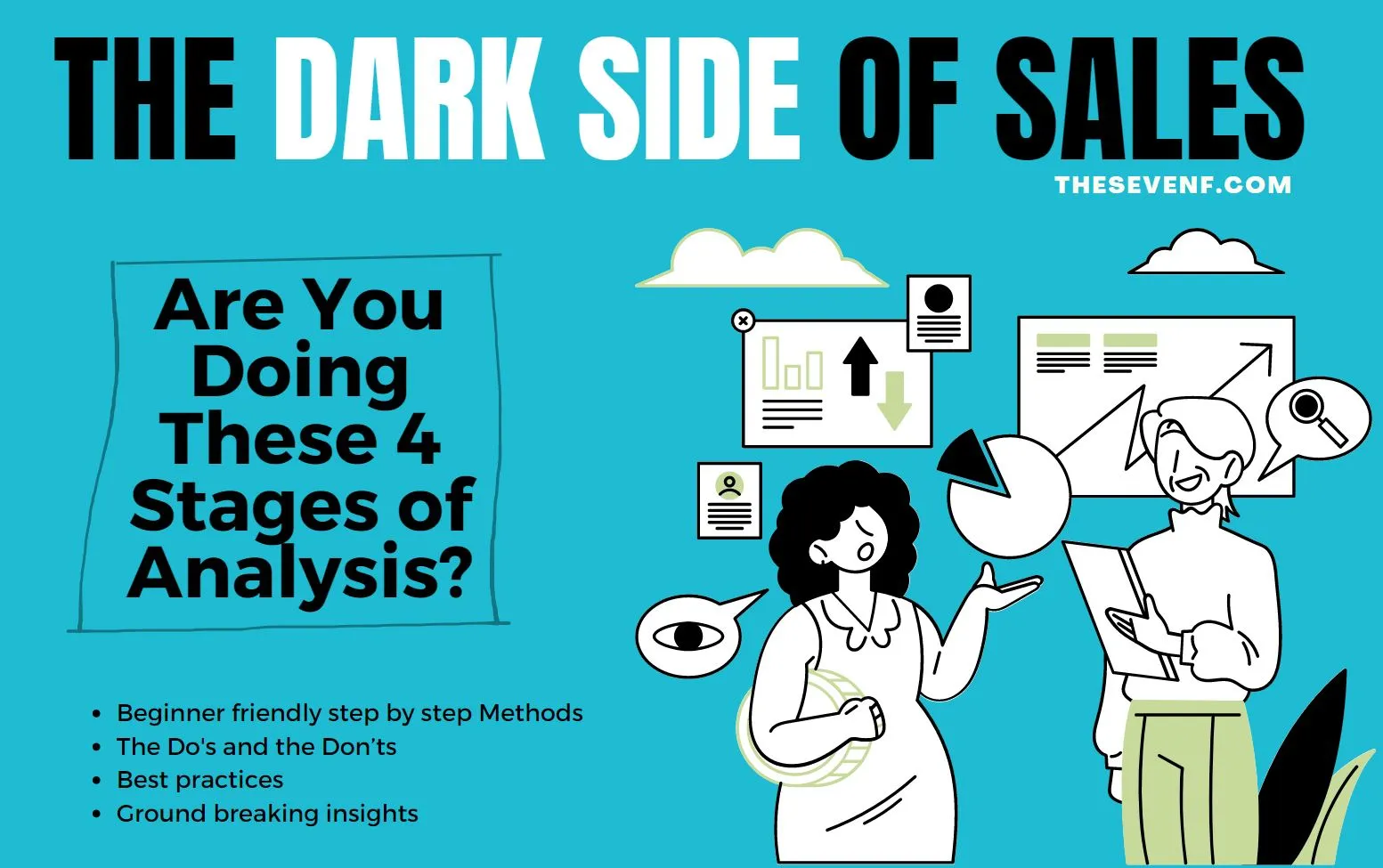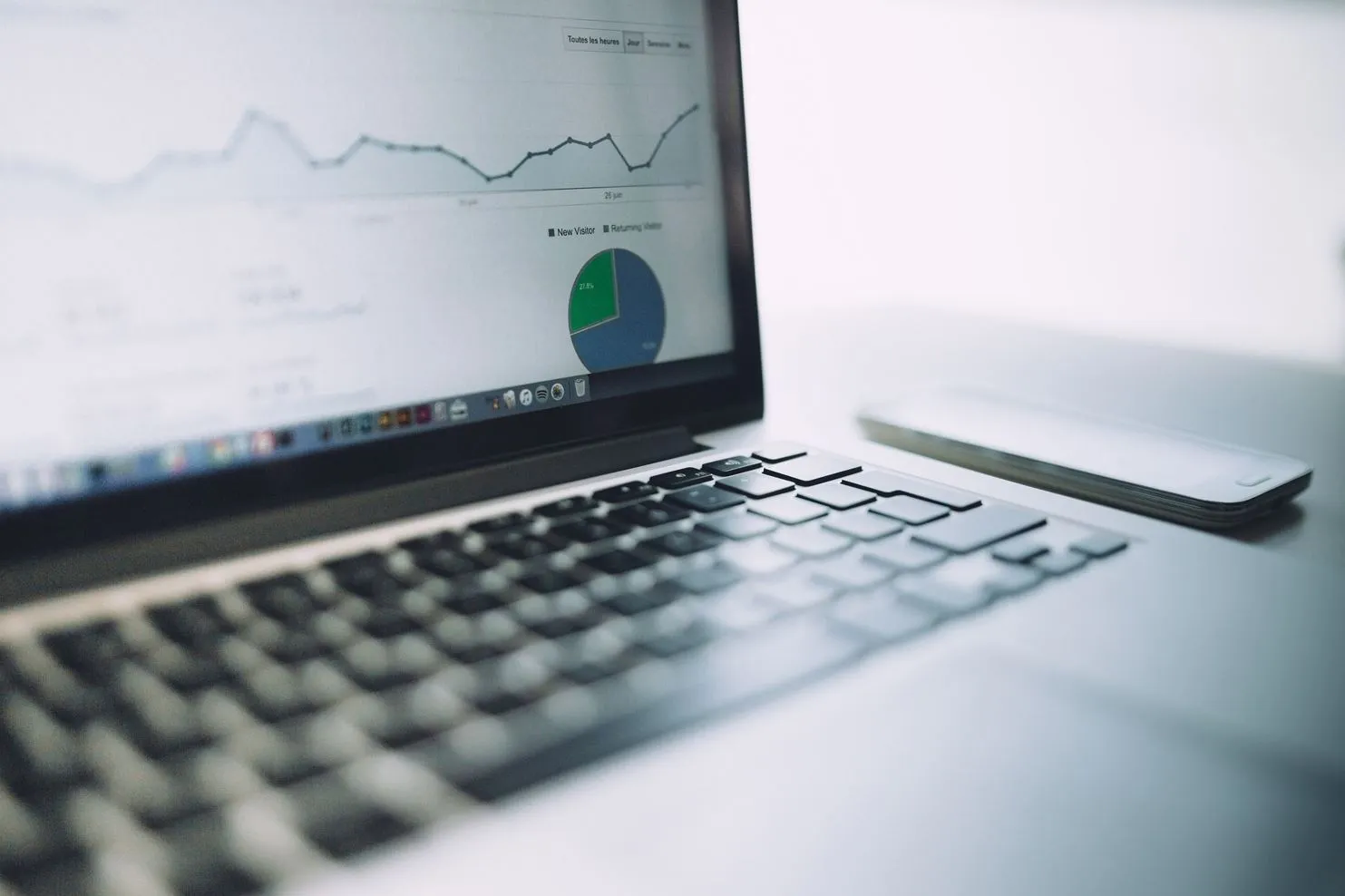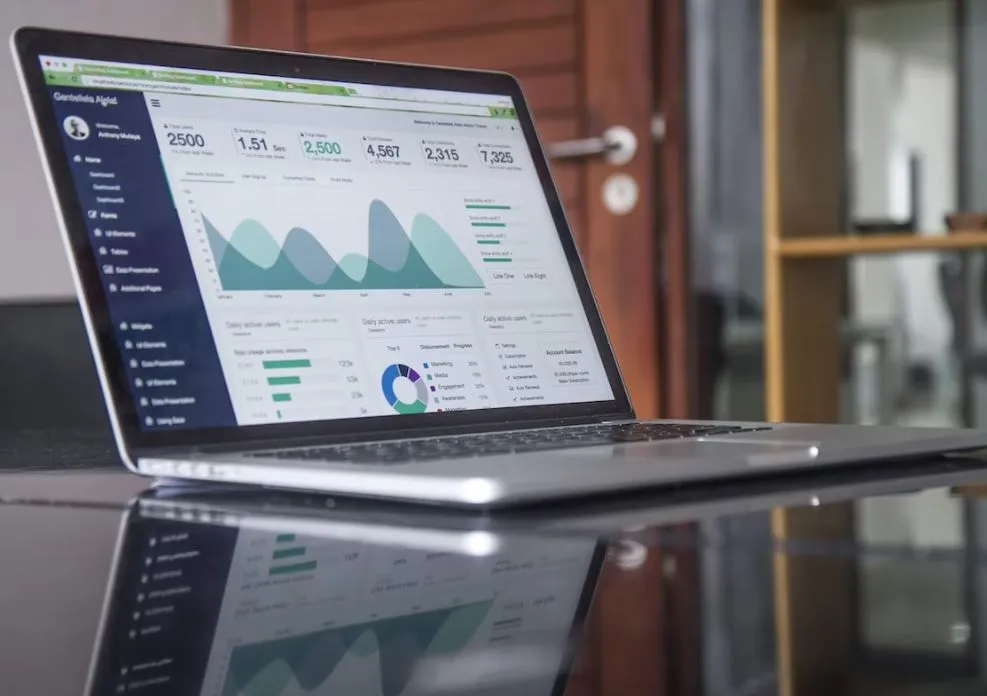The Dark Side of Sales: How Ignoring These Four Stages of Analytics Could be Costing You Millions!
The article explains how companies that only use descriptive analytics to analyze sales data are missing out on valuable insights that could help them increase revenue and reduce costs. Along with beginner friendly step by step approach on how to perform these 4 stages, the Do's and the Don’ts, best practices and some ground breaking insights.

What Are You Missing When You Use ONLY Descriptive Analysis in Your Sales Data?
Customer Segmentation:
Descriptive analytics can show which products are selling well and which aren't, but it may not provide information on which customer segments are buying those products. By analyzing sales data with Diagnostic analysis, predictive or prescriptive analytics, companies could identify which customer segments are most profitable, and then tailor their marketing and sales strategies accordingly.
For example, they could develop targeted promotions and incentives to attract new customers or retain loyal ones.
Churn Analysis:
Churn analysis involves analyzing customer data to identify the reasons why customers are leaving or canceling services. This is a classic example of Diagnostic analysis. By analyzing sales data alongside customer data, companies can :identify patterns in customer behavior that may be contributing to churn. This can help them develop strategies to retain customers and reduce churn.
Sales Performance Analysis:
Sales performance analysis involves analyzing sales data to identify patterns in sales performance and understand the root causes of underperformance. another example of example of Diagnostic analysis. This can help companies identify areas where sales reps may need additional training or support, as well as identify areas where sales processes may need to be optimized.
Demand Forecasting:
Descriptive analytics can tell you what happened in the past, but it may not provide insights into future demand. By using predictive analytics to analyze historical sales data, companies can develop accurate demand forecasts that can help them optimize inventory levels and reduce waste. This, in turn, can help them increase revenue and reduce costs.
Pricing Optimization:
Descriptive analytics can provide information on sales volume and revenue by product, but it may not provide insights into how pricing affects customer behavior. By using predictive analytics to analyze sales data, companies can identify which price points are most likely to result in sales and which are likely to deter customers. This information can help them optimize their pricing strategies to increase revenue and reduce costs.
Cross-Selling and Upselling:
Descriptive analytics can tell you which products are frequently bought together, but it may not provide insights into why customers are making those purchases. By using predictive analytics to analyze sales data, companies can identify patterns in customer behavior and develop targeted cross-selling and upselling strategies. This can help them increase revenue by encouraging customers to buy additional products and services.
Sales Forecasting:
Predictive analytics can help companies forecast future sales and revenue by analyzing historical data and identifying patterns and trends. This can help them make more accurate budget and resource allocation decisions, as well as better prepare for potential changes in demand.
Inventory Management:
Predictive analytics can help companies optimize their inventory levels by forecasting future demand and identifying patterns in stockouts and overstocking. This can help them reduce costs associated with excess inventory and lost sales, as well as improve customer satisfaction by ensuring products are available when needed.
Sales Channel Optimization:
Descriptive analytics can tell you which sales channels are performing well and which are not, but it may not provide insights into how to optimize those channels. By using prescriptive analytics to analyze sales data, companies can identify which channels are most effective for reaching different customer segments and which channels are most cost-efficient. This information can help them make informed decisions about where to allocate their resources and how to optimize their sales channels to increase revenue and reduce costs.
Sales Territory Optimization:
Prescriptive analytics can help companies optimize their sales territories by analyzing customer data and identifying patterns in customer behavior. This can help them assign sales reps to the most promising territories, as well as identify areas where additional sales resources may be needed.
Promotion Optimization:
Prescriptive analytics can help companies optimize their promotional strategies by analyzing customer behavior and identifying which promotions are most effective. This can help them increase sales and revenue by targeting promotions to the customers most likely to respond to them.
Now that we understood what we are missing when we are doing only the descriptive analysis, now lets understand these 4 stages of analytics, and how exactly you need to perform those analysis, what are the DO's and the Don'ts, What are the best practices, and some ground breaking insights to take your business to the next level using data analysis
4 Stages of Sales Analytics
- ✅ Descriptive Analytics: The first stage of analytics involves summarizing and analyzing historical data to gain insights about what happened in the past. Descriptive analytics typically uses techniques such as data aggregation, data visualization, and summary statistics to identify patterns, trends, and anomalies in the data.
- ✅ Diagnostic Analytics: The second stage of analytics focuses on understanding why something happened by digging deeper into the data. Diagnostic analytics uses techniques such as correlation analysis, root cause analysis, and hypothesis testing to identify the underlying causes of specific outcomes. This also requires business understanding, logical thinking and focused research skills.
- ✅ Predictive Analytics: The third stage of analytics involves using historical data to generate predictions about future events. Predictive analytics uses techniques such as regression analysis, time series analysis, and machine learning algorithms to identify patterns and trends that can be used to forecast future outcomes.
- ✅ Prescriptive Analytics: The final stage of analytics involves using the insights gained from the previous stages to make better decisions for the future. Prescriptive analytics uses techniques such as optimization algorithms, simulation models, and decision trees to provide recommendations for future actions. By leveraging the insights gained from descriptive, diagnostic, and predictive analytics, organizations can make data-driven decisions that improve business outcomes.
🔴 Descriptive Analysis: An Essential Guide
In today's data-driven world, businesses have access to a vast amount of data. However, it can be challenging to make sense of this data and use it effectively to make informed business decisions. Descriptive analytics can help businesses gain insights from their sales data and understand what has happened in the past, identify trends, and make predictions for the future.
In the following, we will discuss.
- 💥 what descriptive analytics is,
- 💥 how to perform it,
- 💥 roadblocks to watch out for,
- 💥 considerations to make before starting this analysis, and
- 💥 the tools you can use.
Descriptive analytics provides a foundation for further analysis and decision-making, such as predictive and prescriptive analytics.
✔️ Steps to Perform Descriptive Analytics on Sales Data:
Performing descriptive analytics on sales data involves the following steps:
- ⭕ Define the business question: The first step in descriptive analytics is to define the business question you want to answer. For example, you may want to know what products are selling the most or what regions have the highest sales.
- ⭕ Collect and clean the data: Collect the relevant data for your analysis and clean it to ensure it is accurate and consistent. Data cleaning involves removing duplicates, fixing missing values, and ensuring that data is in the correct format. Check out the article which covers The ultimate 6 steps you can follow to collect and clean your data.
- ⭕ Explore the data: Once you have the data, explore it to understand its characteristics. This step involves summarizing the data using descriptive statistics such as mean, median, mode, range, and standard deviation. This helps to identify outliers and understand the distribution of the data.
- ⭕ Visualize the data: Use charts and graphs to visualize the data to identify trends and patterns. This can be done using tools like Excel, Tableau, or Power BI.
- ⭕ Draw insights: Based on the data exploration and visualization, draw insights that answer the business question. For example, if you were trying to understand which products sold the most, you might identify the top-selling products and their sales trends over time.
- ⭕ Communicate the insights: Finally, communicate the insights to stakeholders in a clear and concise way. This can be done using reports or presentations.
✔️ Roadblocks to Watch Out for and How to Overcome Them:
Performing descriptive analytics on sales data can be challenging, and there are some roadblocks to watch out for, including:
- ⭕ Data quality issues: If the data is of poor quality, the analysis may produce inaccurate or misleading results. To overcome this, ensure that the data is clean and accurate before performing any analysis.
- ⭕ Lack of domain expertise: Without a thorough understanding of the business domain, it can be challenging to interpret the data and draw meaningful insights. To overcome this, work with subject matter experts who have a deep understanding of the business domain.
- ⭕ Choosing the right visualizations: Choosing the wrong visualizations can make it difficult to identify trends and patterns in the data. To overcome this, choose visualizations that are appropriate for the data and the business question.
- ⭕ Limited data availability: If the data is limited, it may be difficult to draw meaningful insights. To overcome this, consider using external data sources or conducting additional research to supplement the existing data.
✔️ Considerations Before Starting Descriptive Analytics:
Before starting descriptive analytics on sales data, consider the following:
- ⭕ Define the scope of the analysis: Define the scope of the analysis and identify the key metrics and data sources that will be used. This will help to focus the analysis and ensure that it is relevant to the business question.
- ⭕ Identify the audience: Consider who will be consuming the insights and tailor the analysis to their needs. For example, executives may require high-level summaries, while analysts may need more detailed reports.
- ⭕ Determine the frequency of analysis: Decide how frequently the analysis will be performed, whether it is a one-time analysis or ongoing. This will impact the data collection and cleaning processes and the tools used for visualization and reporting.
✔️ Tools for Descriptive Analytics on Sales Data:
There are many tools available for performing descriptive analytics on sales data. Some popular tools include:
- ⭕ Microsoft Excel: Excel is a widely used spreadsheet tool that can be used for data cleaning, exploration, and visualization.
- ⭕ Tableau: Tableau is a powerful data visualization tool that allows users to create interactive dashboards and reports.
- ⭕ Power BI: Power BI is a business intelligence tool that can be used to create interactive visualizations and reports.
- ⭕ Python: Python is a programming language that is widely used for data analysis and visualization. It has many libraries and packages that can be used for descriptive analytics.
In Summary, Descriptive analytics is a valuable tool for understanding sales data and identifying trends and patterns. By following the steps outlined above and using the appropriate tools, businesses can gain insights that inform decision-making and drive business growth. It is important to consider the roadblocks and considerations before starting the analysis to ensure that it is accurate, relevant, and valuable to stakeholders.
🔴 Diagnostic Analysis: Your Pocket Guide
Diagnostic analytics is a type of data analysis that focuses on identifying the root causes of problems or issues within a business. This approach is particularly useful in the context of sales data, where it can help to identify factors that are impacting sales performance and revenue generation. In this article, we'll explore the steps involved in conducting a diagnostic analysis of sales data, including how to perform each step, roadblocks that may arise, how to remove bottlenecks, and considerations to keep in mind.
Few questions that diagnostic analysis can answer related to the performance of your business are:
- ❓ What factors are driving changes in sales and revenue over time?
- ❓ Are there any trends or patterns in sales and revenue data that can be identified and used to improve business performance?
- ❓ Which products or services are driving revenue growth, and which are underperforming?
- ❓ Are there any sales channels or customer segments that are performing better or worse than expected?
- ❓ What impact are external factors, such as changes in the economy or competitive landscape, having on sales and revenue?
- ❓ Are there any pricing or discount strategies that are impacting revenue negatively or positively?
- ❓ Are there any operational issues, such as inventory management or supply chain problems, that are impacting sales and revenue?
By analyzing sales and revenue data in a systematic way, businesses can gain insights into their performance and make data-driven decisions to improve their bottom line.
Steps to Perform Diagnostic Analytics on Sales Data:
✔️ Step 1: Define the Problem statement:
The first step in any diagnostic analysis is to define the problem or issue that needs to be addressed. In the context of sales data, this might involve identifying why sales have declined or why certain products are not selling as well as expected.
To perform this step, it's important to gather as much information as possible about the problem, including any data that may be relevant. This might include sales data, customer data, marketing data, and any other data that may be relevant.
Roadblocks:
One of the main roadblocks in this step is a lack of clarity around the problem or issue. It's important to define the problem in a clear and specific way, so that the analysis can be focused and targeted.
Bottleneck:
To remove bottlenecks, it may be helpful to gather input from multiple stakeholders, including sales representatives, marketing teams, and customer service teams. This can help to identify different perspectives on the problem and ensure that the analysis is comprehensive.
✔️ Step 2: Develop a Hypothesis
Once the problem has been defined, the next step is to develop a hypothesis about what might be causing the issue. This hypothesis should be based on the available data and any insights that have been gathered from stakeholders. In the context of sales data, this might involve hypothesizing that sales have declined due to changes in the market or due to a particular product line underperforming.
Roadblocks:
One of the main roadblocks in this step is a lack of data or insights. It's important to gather as much information as possible before developing a hypothesis, to ensure that it's based on solid evidence.
Bottleneck:
To remove bottlenecks, it may be helpful to conduct a brainstorming session with stakeholders to generate multiple hypotheses. This can help to ensure that the analysis is comprehensive and that all potential causes are considered.
✔️ Step 3: Test the Hypothesis
Once a hypothesis has been developed, the next step is to test it using the available data. This might involve performing statistical analyses to identify correlations between different variables or conducting a deeper dive into the sales data to identify patterns or trends.
Roadblocks:
One of the main roadblocks in this step is a lack of expertise in statistical analysis. It's important to have someone on the team who is comfortable with statistical methods and can perform the necessary analyses.
Bottleneck:
To remove bottlenecks, it may be helpful to collaborate with an outside consultant or to invest in training for the team. Alternatively, there may be software or tools available that can automate some of the statistical analysis.
✔️ Step 4: Draw Conclusions
Once the hypothesis has been tested, the next step is to draw conclusions based on the available evidence. This might involve identifying specific factors that are impacting sales or developing recommendations for improving sales performance.
Roadblocks:
One of the main roadblocks in this step is a lack of clarity around the conclusions. It's important to ensure that the conclusions are based on solid evidence and that they are communicated clearly and effectively.
Bottleneck:
To remove bottlenecks, it may be helpful to work with a team that includes individuals with expertise in communication and data visualization. This can help to ensure that the conclusions are presented in a clear and compelling way and that stakeholders can easily understand the implications of the analysis.
✔️ Step 5: Implement Recommendations
The final step in a diagnostic analysis of sales data is to implement recommendations based on the conclusions drawn from the analysis. This might involve making changes to sales processes, adjusting marketing strategies, or modifying product offerings.
Roadblocks:
One of the main roadblocks in this step is resistance to change. It's important to communicate the rationale behind the recommendations and to work collaboratively with stakeholders to ensure that changes are implemented effectively.
Bottleneck:
To remove bottlenecks, it may be helpful to establish a clear plan for implementing recommendations, including timelines and responsibilities. This can help to ensure that everyone is on the same page and that the implementation process is as smooth as possible.
Overall, conducting a diagnostic analysis of sales data can be a powerful tool for businesses looking to identify the root causes of sales performance issues and make data-driven decisions to improve revenue generation. By following these steps and addressing any roadblocks or bottlenecks that may arise, businesses can gain valuable insights and take action to improve their sales performance.
🔴 Predictive Analysis: A Beginner’s Guide for All
Predictive analytics is a powerful tool for businesses to gain insights into their sales data and use that information to make better decisions about their operations. Predictive analytics involves the use of data, statistical algorithms, and machine learning techniques to identify the likelihood of future outcomes based on historical data. In this article, we will outline the steps for performing predictive analytics on sales data, discuss potential roadblocks that can arise during each step, and provide recommendations for overcoming those roadblocks.
Steps for Predictive Analytics on Sales Data
✔️ Step 1: Define the problem and identify the data needed:
The first step in predictive analytics is to clearly define the problem you are trying to solve. For example, you might want to predict which customers are most likely to make a purchase, or which products are most likely to sell in a particular region.
Once you have defined the problem, you need to identify the data that will be needed to solve it. This could include data about customers, products, sales history, and other relevant factors.
Potential roadblocks:
It can be difficult to know exactly which data will be most useful for solving the problem, and it may be necessary to collect additional data or clean up existing data before it can be used for analysis.
✔️ Step 2: Data preparation and cleaning
Once you have identified the data needed, the next step is to prepare and clean that data. This involves removing any duplicates or irrelevant data, filling in missing values, and transforming the data into a format that can be easily analyzed.
Potential roadblocks:
Data preparation can be time-consuming, and it can be difficult to know which data transformations are necessary for accurate analysis.
✔️ Step 3: Exploratory data analysis
Before performing predictive analytics, it is important to explore the data and identify any patterns or relationships that may be present. This can involve using descriptive statistics, data visualization tools, and other exploratory techniques to gain a better understanding of the data.
Potential roadblocks:
It can be difficult to know which exploratory techniques will be most effective for a given dataset, and it can be time-consuming to perform multiple analyses to find the most useful insights.
✔️ Step 4: Model selection and development
Once the data has been prepared and analyzed, the next step is to select an appropriate model for predicting future outcomes. This could involve using regression models, decision trees, or other machine learning algorithms to identify patterns in the data and make predictions about future outcomes.
Potential roadblocks:
It can be challenging to select the right model for a given dataset, and it may be necessary to try multiple models to find the most accurate one.
✔️ Step 5: Model evaluation and validation
After developing a model, it is important to evaluate its accuracy and validate its predictions using new data. This can involve testing the model on a subset of the data or using a holdout dataset to validate its performance.
Potential roadblocks:
It can be difficult to know whether a model is performing well, and it may be necessary to adjust the model or collect additional data to improve its accuracy.
Things to Consider Before Starting Predictive Analytics on Your Sales Data
Before embarking on predictive analytics on sales data, there are several important factors to consider. These include:
- ⭕ Data quality: The accuracy and completeness of the data will have a significant impact on the accuracy of the predictive model.
- ⭕ Data governance: It is important to have clear guidelines for how data is collected, stored, and used to ensure consistency and accuracy.
- ⭕ Data privacy: Predictive analytics may involve using sensitive customer data, and it is important to ensure that all privacy regulations are being followed.
- ⭕ Skillset: Predictive analytics requires a range of technical skills, including statistical analysis, programming, and machine learning.
Removing Bottlenecks in Predictive Analytics
To overcome the potential roadblocks that can arise during each step of predictive analytics, it is important to have a clear plan and a team with the right skills and expertise. This could involve:
- ⭕ Building a team with a range of skills, including data analysis, programming, and machine learning.
- ⭕ Setting clear goals and milestones for each step of the process.
- ⭕ Using automated tools for data preparation and cleaning to save time and improve accuracy.
- ⭕ Using iterative modeling techniques to quickly test and refine models.
- ⭕ Continuously monitoring the model's performance and making adjustments as needed.
Tools for Predictive Analytics on Sales Data
There are many tools available for performing predictive analytics on sales data, ranging from open-source software to commercial platforms. Some popular tools include:
Python: Python is a popular programming language for data analysis and has many libraries for machine learning and predictive modeling, such as Scikit-Learn, TensorFlow, and Keras.
R: R is another popular programming language for statistical analysis and has many packages for predictive modeling, such as caret, randomForest, and glmnet.
Microsoft Excel: Excel can be used for basic predictive modeling and has built-in tools for regression analysis and data visualization.
Tableau: Tableau is a powerful data visualization tool that can be used for exploratory data analysis and creating visualizations for predictive models.
RapidMiner: RapidMiner is a commercial data science platform that includes tools for data preparation, modeling, and deployment.
IBM Watson Studio: IBM Watson Studio is another commercial data science platform that includes tools for predictive modeling, as well as data preparation and deployment.
Bottomline,
Predictive analytics is a powerful tool for businesses to gain insights into their sales data and make better decisions about their operations. By following the steps outlined in this article, businesses can perform effective predictive analytics on their sales data and overcome potential roadblocks that can arise during the process. By considering the factors to consider before starting, and using the right tools and techniques, businesses can unlock valuable insights that can drive growth and improve their bottom line.
🔴 Prescriptive Analysis: An Essential Guide
Prescriptive analytics is a type of data analysis that involves using predictive models and optimization techniques to identify the best course of action to take in a given situation to improve particular outcome.
In the context of sales data, prescriptive analytics can help companies make informed decisions about pricing, promotions, and inventory management.
In essence, predictive analysis helps organizations to forecast what might happen in the future, while prescriptive analysis helps them to determine what actions they should take based on those predictions. While predictive analysis focuses on identifying the future, prescriptive analysis focuses on taking action to achieve the desired outcomes.
✔️ Here are the steps to take for this analysis:
1. Define the problem:
Identify the business problem that prescriptive analytics can help solve. This could be improving sales revenue, reducing inventory costs, or optimizing pricing strategies.
2. Collect and clean data:
Gather sales data from various sources, such as point-of-sale systems, CRM systems, and marketing campaigns. Clean the data to remove duplicates, missing values, and errors.
3. Analyze data:
Use statistical methods and data visualization tools to identify patterns and trends in the sales data. This step involves descriptive analytics to understand what happened.
4. Build predictive models:
Use machine learning algorithms to develop predictive models that can forecast future sales trends based on historical data. This step involves predictive analytics to understand what could happen.
5. Perform optimization:
Use mathematical optimization techniques to identify the best course of action based on the predictive models. This step involves prescriptive analytics to understand what should happen.
6. Implement solutions:
Implement the recommended solutions based on the prescriptive analytics insights. Monitor the results and adjust the models and strategies as needed.
✔️ Roadblocks and Bottlenecks:
✅ Data quality issues:
Incomplete or inaccurate data can negatively affect the accuracy of the prescriptive analytics insights. To overcome this, companies need to ensure that the data is accurate, complete, and reliable.
✅ Lack of expertise:
Prescriptive analytics requires a high level of technical expertise in statistics, machine learning, and optimization. To overcome this, companies can hire data analysts or work with external consultants.
✅ Resistance to change:
Implementing prescriptive analytics insights may require changes in the organization's processes and culture. To overcome this, companies need to communicate the benefits of prescriptive analytics and involve stakeholders in the decision-making process.
✔️ Things to Consider:
Data privacy and security: Companies need to ensure that the sales data they use for prescriptive analytics is protected and complies with data privacy regulations.
Cost-effectiveness: Implementing prescriptive analytics solutions can be costly. Companies need to weigh the benefits against the costs to ensure that the investment is cost-effective.
✔️ Tools to Use:
Statistical software: Tools such as R and Python can be used for data analysis, machine learning, and optimization.
Visualization software: Tools such as Tableau and Power BI can be used to create interactive visualizations to explore and communicate the insights from the data.
Cloud platforms: Cloud platforms such as Amazon Web Services and Microsoft Azure provide scalable and cost-effective solutions for data storage, processing, and analytics.
Bottomline,
prescriptive analytics can help companies make informed decisions about sales strategies based on data-driven insights. By following the steps outlined above, companies can overcome roadblocks and bottlenecks, consider important factors, and use the right tools to implement prescriptive analytics solutions.
🔴 Stats:
- According to a report by McKinsey, companies that use descriptive analytics can improve their decision-making by up to 10%.
- According to a survey by Deloitte, companies that use diagnostic analytics see a 20% reduction in the time it takes to identify the root cause of problems.
- According to a study by McKinsey, companies that use predictive analytics see a 20% increase in customer satisfaction and a 15% increase in revenue.
- According to a report by Frost & Sullivan, companies that use prescriptive analytics see a 10-20% improvement in operational efficiency.







